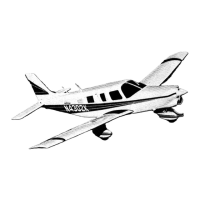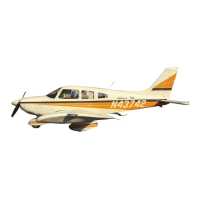6.7 WEIGHT AND BALANCE DETERMINATION FOR FLIGHT
(a) Add the weight of all items to be loaded to the basic empty weight.
(b) Use the Loading Graph (Figure 6-15) to determine the moment of
all items to be carried in the airplane.
(c) Add the moment of all items to be loaded to the basic empty weight
moment.
(d) Divide the total moment by the total weight to determine the C.G.
location.
(e) By using the figures of item (a) and item (d) (above), locate a point
on the C.G. range and weight graph (Figure 6-17). If the point falls
within the C.G. envelope, the loading meets the weight and balance
requirements.
Arm Aft
Weight Datum Moment
(Lbs.) (Inches) (Lb-In.)
Basic Empty Weight 1169.0 73.2 85570
Pilot and Passenger** 340.0 85.5 29070
Fuel (30 Gallon Maximum) 61.0 75.4 4599
Baggage (100 Lbs. Maximum)* 100.0 115.0 11500
Total Loaded Airplane 1670.0 78.3 130739
The center of gravity (C.G.) of this sample loading problem is at 78.3 inches
aft of the datum line. Locate this point (78.3) on the C.G. range and
weight graph. Since this point falls within the weight - C.G. envelope, this
sample loading meets the weight and balance requirements.
IT IS THE RESPONSIBILITY OF THE PILOT AND AIRCRAFT
OWNER TO INSURE THAT THE AIRPLANE IS LOADED
PROPERLY.
* No baggage allowed for spins.
** Occupant C.G. is shown with the seats in the fourth notch from the most
forward position. See Figure 6-14 for the seat position and corresponding
arm aft datum.
SAMPLE LOADING PROBLEM (NORMAL CATEGORY)
Figure 6-11
PIPER AIRCRAFT CORPORATION SECTION 6
PA-38-112, TOMAHAWK WEIGHT AND BALANCE
ISSUED: JANUARY 20, 1978 REPORT: 2126
REVISED: JUNE 6, 1979 6-9
6.7 WEIGHT AND BALANCE DETERMINATION FOR FLIGHT
(a) Add the weight of all items to be loaded to the basic empty weight.
(b) Use the Loading Graph (Figure 6-15) to determine the moment of
all items to be carried in the airplane.
(c) Add the moment of all items to be loaded to the basic empty weight
moment.
(d) Divide the total moment by the total weight to determine the C.G.
location.
(e) By using the figures of item (a) and item (d) (above), locate a point
on the C.G. range and weight graph (Figure 6-17). If the point falls
within the C.G. envelope, the loading meets the weight and balance
requirements.
Arm Aft
Weight Datum Moment
(Lbs.) (Inches) (Lb-In.)
Basic Empty Weight 1169.0 73.2 85570
Pilot and Passenger** 340.0 85.5 29070
Fuel (30 Gallon Maximum) 61.0 75.4 4599
Baggage (100 Lbs. Maximum)* 100.0 115.0 11500
Total Loaded Airplane 1670.0 78.3 130739
The center of gravity (C.G.) of this sample loading problem is at 78.3 inches
aft of the datum line. Locate this point (78.3) on the C.G. range and
weight graph. Since this point falls within the weight - C.G. envelope, this
sample loading meets the weight and balance requirements.
IT IS THE RESPONSIBILITY OF THE PILOT AND AIRCRAFT
OWNER TO INSURE THAT THE AIRPLANE IS LOADED
PROPERLY.
* No baggage allowed for spins.
** Occupant C.G. is shown with the seats in the fourth notch from the most
forward position. See Figure 6-14 for the seat position and corresponding
arm aft datum.
SAMPLE LOADING PROBLEM (NORMAL CATEGORY)
Figure 6-11
PIPER AIRCRAFT CORPORATION SECTION 6
PA-38-112, TOMAHAWK WEIGHT AND BALANCE
ISSUED: JANUARY 20, 1978 REPORT: 2126
REVISED: JUNE 6, 1979 6-9
